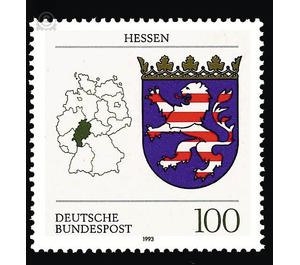Coat of arms of the Land of the Federal Republic of Germany (2) - Germany / Federal Republic of Germany 1993 - 100 Pfennig
Theme: Art & Culture
| Country | Germany / Federal Republic of Germany |
| Issue Date | 1993 |
| Face Value | 100.00 |
| Color | white blue |
| Perforation | K 13 3/4 |
| Printing Type | Multicolor offset printing |
| Stamp Type | Postage stamp |
| Item Type | Stamp |
| Chronological Issue Number | 1533 |
| Chronological Chapter | GER-BRD |
| SID | 875671 |
| In 52 Wishlists | |
The Hessian coat of arms shows in blue shields a nine times silver and red divided rising lion with golden claws. On the shield rests a thread of golden foliage with fruits formed by blue pearls (law on the emblems of the state of Hesse on 4 August 1948). Following the heraldic principles of the lion in the Hessian coat of arms in general is shown in red and white striped. Hesse is until 1247 only the western part of the Landgraviate of Thuringia, and in fact the Hessian lion is the Landgrave of Thuringia. After the extinction of the Thuringian landgraves, it is continued by both Landgraviate, Thuringia and Hesse - certainly as a sign of the claim to the whole, undivided old rural county. Landgrave Ludwig III. from Thuringia leads in 1182 on his riding mirror for the first time a lion in the shield, which was probably striped from the beginning red and white. This red-white stripe is probably of Mainz origin, because the landgraves of Thuringia were archmages of the Archbishop of Mainz. Since the separation of Thuringia, the red-and-white lion in the blue shield remains Hessen's coat of arms. The number of divisions is negligible; it appears divided from three to eleven times, and only in the 19th and 20th centuries, the number of divisions was officially determined. In the name of this Hessian lion Hessian history is now going on: from the landgrave coat of arms he becomes the country emblem. Both Hessians lead him after the unfortunate country division of 1568, which they should lead in the Thirty Years' War on the various sides - a fratricidal war under flags with the Hessian lion. Hessen-Darmstadt gave his lion a sword in 1808 in the Pranke, the Kurhessian lion led after the annexation of 1866 only a shadowy existence in the great Prussian coat of arms. The people's state Hessen took in 1920 the Hessian lion without crown and sword as state coat of arms, as well as 1946 the new country Hessen. Today, Hesse is one of the economically strongest federal states, which has one of the economically most dynamic growth areas in the Rhine-Main region. Hesse has 5.8 million inhabitants and an area of 21,000 km2. (Text: Hessian Ministry of the Interior and for European Affairs using a contribution by Hans Enno Korn)


